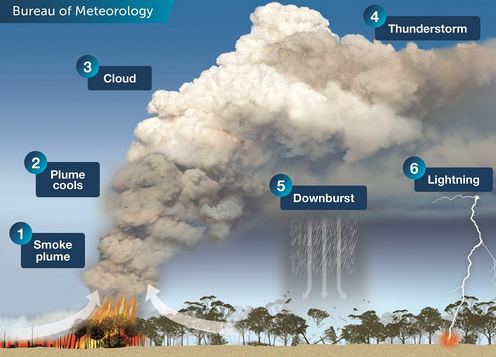
As ATSB investigators probe the loss of the Hercules air tanker N134 during a bushfire drop in January, they will undoubtedly turn back the pages of accident reports into other C-130 crashes. All three American members of the crew of N134, owned and operated by the Canadian Coulson company, were killed in the accident.
The Hercules military transport has been widely used around the world for aerial firefighting, either by air forces or civilian contractors who have undertaken extensive and costly fitouts. More than fifty versions of the aircraft were developed, and the structural strength of the airframe has been improved over the years. In one of the first accidents involving a converted U.S. Air Force plane in 2002, the wings were seen to have folded (watch the video below), then broken off. The fuselage rolled over and crashed upside down. But this was a C-130A model, with a proven weak main spar. Later models have completely re-designed wings.
The most significant crash that Australian investigators will consider is the destruction of a Hercules in South Dakota in July 2012, because it seems to parallel the accident in Snowy-Monaro. Both aircraft left tell-tale skid marks along the ground before they erupted in flames, as if they had executed a wheels-up landing. In South Dakota, four men died and two crew members in the rear were injured but survived.
The final report of the U.S. National Transportation Safety Board found that a thunderstorm microburst — a vicious downdraft — had caused the aircraft to lose altitude as it made its second drop run. Flying so low, at about 150 feet, it had been virtually pushed onto the ground. The report was critical of the pilots for disregarding warning conditions they encountered on their first run: the plane was sinking despite full power. The lead plane, half a mile ahead, came within ten feet of the ground when it also experienced the microburst, but it did not call off the drop. The Bureau of meteorology graphic below illustrates how severe fires generate their own weather conditions, including a downdrafts (5) that can make it all but impossible to keep a low-flying plane in the air.

Whether the Coulson Hercules should have been on that mission at all might well come under scrutiny. One experienced pilot who has been involved in aerial firefighting, Juan Browne who operates the ‘Blancolirio’ blog says the wind gusts in the drop zone were as high as 60 miles per hour (100 kph). He asks: “Why were air tankers there at all?” (see Browne’s video below) He points out that the utility of these big aircraft is often limited by visibility, smoke turbulence, rugged terrain, and the fatigue of the pilots. They cannot be used everywhere, all the time.
There is a much bigger question, unrelated to the recent crash: how effective are these air tankers, on a cost/benefit basis. With the enthusiastic stampede to bigger and bigger aircraft, like the NSW government’s $26m 737 airliner (35,000 litres), and the Prime Minister’s rush order of four even bigger DC-10 aircraft (45,000 litres), Australia seems to hypnotised into believing bigger is better. Perhaps they should read veteran forester Roger Underwood’s essay at Quadrant Online, “The Bushfire-Industrial Complex“.
These planes all require major airfields as their bases, meaning long flight times to reach the fires. (In New South Wales they operate from RAAF Richmond on Sydney’s outskirts, in Victoria from RAAF East Sale). How sensible (or effective) was the Hercules mission from Richmond, two hours to the Snowy to drop one load of 11,000 litres of retardant? And how sensible is it to fly these big aircraft so close to the ground when they are so unmanoeuvrable and depend on a lead aircraft to “see” for them?
Geoffrey Luck, a veteran pilot, was an ABC journalist from 1950 until 1976. In an earlier article he recalled how inexperience and power lines very nearly cost him his life
 Sign In
Sign In 0 Items (
0 Items ( Search
Search









Apart from targeted property protection (and even that can be dubious), if you are using aerial tankers you have lost already. All the stuff you should have done you clearly haven’t. And governments clearly haven’t.
The new policy of the emergency services appears to be “At the first puff of smoke evacuate everyone and let it burn. The houses are insured. They can rebuild afterwards”
The new policy of home owners in the fire zones appears to be “At the first puff of smoke Im out of here. The house is insured. Ill rebuild afterwards”
I’m wondering just what the insurance companies feel when they suddenly discover that they are the only ones left on the front line. Everyone else has gone!
Geoffrey is right. Water bombers are just virtue signalling B.S.
It’s the American way – bomb everything.
The water bombers’ intent was to save a facility caring for injured wildlife in the Australian Alpine region.
The MOGO zoo on the South Coast was told to leave, but stayed and fought.
The reported conversation to me was.
‘You have to leave’
‘But what about the animals?’
‘The will have to stay.’
The staff stayed and fought.
Some of it is here…
https://www.abc.net.au/news/2019-12-31/mogo-zoo-and-animals-within-saved-from-bushfire/11834918
The outcome was excellent.
It was with the best intent that the overseas water bombers went about their task in the Snowy.
But for them and others, the whole lot of the facility would have gone up.
Such facilities need wide cleared areas, seconding as exercise yards or free play for the animals, to ring fence them from the inevitable flames.
Speaking without any special knowledge.
One of the theories about the loss of aircraft over the Bermuda Triangle is that they run out of oxygen because of methane release.
This theory is controversial, but the principal remains that ash, CO2, CO, released short chained hydrocarbons and water vapour, being sucked into the engine intakes, would mean a loss of power derived from ignition of fuel.
The aircraft was flying through such a place where this is occurring.
Once the aircraft stalled at a couple of hundred feet, it would belly into the ground,leaving a skid track.
Any fuel leak, or unburnt fuel pouring from the engines, would be ignited by the ever present fire.
Thanks, Geoffrey Luck.
Our prediction is that supply/lease of such aircraft and associated big dollar equipment will be increased by the State Govts as a cover for hazard reduction failures, both past and future.
The Fed RC if it eventuates will be hobbled by bench appointments and terms of reference. The State Govts, especially NSW and Vic, will conduct their own inquiries as they then control both bench appointments and terms of reference. Berejiklian has already sneakily moved in this area, with the MSM just as sneakily reporting it on page elevently eleven. So drearily predictable – power without accountability.
People die, families and homes are destroyed, front-line firies risk life and limb … govts dissemble, spend huge amounts on political optics and then exit stage left. Bob Carr, with true cynicism, intoned that politicians are not responsible for anything.
Lewis: Interesting, but the aircraft didn’t stall – it flew straight into a gently upsloping hillside under full power. The question is how did it get so low – a microburst (possible but unlikely as there was no thunderstorm activity in the area) or misjudgement. The video shows a one-second drop of retardant mix. The Hercules carries 11,000 litres which can be discharged in 2.2 secs, so it seems likely the aircraft was going round for a second drop. Juan Browne’s comment that drops are normally done downhill is significant, so perhaps the rising ground of a gentle hill caught the pilots anawares.
Rising ground, I think. I imagine they’d have had a radar altimeter that should have alerted them, unless it was out of commission.
So frustrating that media irresponsibility is increasingly part of the problem than any part of a solution. What is wrong with the selection and training of journalists?
What is wrong with the selection and training of journalists?
Wendy Bacon
It’s difficult to think of a sillier use for aircraft. Crop dusting and mustering are at the limits of silliness. Bombing a fire goes above and beyond.
Er, excuse me, but who is lighting these fires and what are they going to do to them? I read that a man caught lighting a bushfire last week at Burrill Lakes on the South Coast was also caught last year lighting a fire in the same area. I guess they counselled him severely after the first arson. I trust that at some stage authorities will address this question, which to most Australians is more important than climate change and journalists will provide us with in-depth information. Porcine aviators.
Geoffrey watch the aircraft just before it goes into the smoke. The nose appears to come up at about the 48 second mark. That could have been fatal so close to the ground, and with a tailwind, and while banking. Perhaps the pilot realised the bank was draining altitude and tried to compensate, but putting the nose up would have slowed the aircraft significantly. Less air speed means less lift, causing it to descend as though landing. Explains the trail left on the ground.
I hope that the tragic deaths of these three men and those others who have died in these recent bushfires are suitably commemorated in the same way as police officers who are killed in the line of duty by having their names on a commemorative wall as the least we can do to remember their selflessness and community spirit.